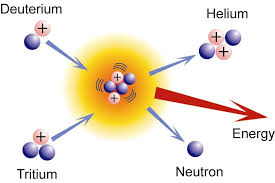"Now, I am become Death, the destroyer of worlds.” ― "J.R Oppenheimer
"The Earth is a lovely place and more or less a placid place. Things change but slowly. We can lead a full life and personally never encounter a natural disaster more violent than a storm. And so we become complacent, relaxed, unconcerned. But in the history of nature the record is clear...even we humans have the dubious technical distinction of being able to make our own disasters, both intentional and inadvertent." - C. Sagan.
The Cold War Starts With A Blast! Nuclear War. Part III
Fusion nuclear weapons, which have proliferated to several countries after their invention in the early 1950's are a serious danger to life on Earth. To ignore the obvious is to deny reality. One of the many sobering facts about nuclear weapons is that they not only do fall into the possession of despotic, unstable, unpredictable regimes - but even nukes under the authority of more stable nations, are arguably, still an accident in the making. The clown must only slip on the banana peel once to bring about unprecedented horror and annihilation - annihilation precisely translated means: "literally to make it nothing".
 |
| THIS |
 |
| PLUS THIS |
EQUALS THIS :)
A psychotic, eschatological or nihilistic regime is one possibility. Another is a country loosing a war and seeing no option but to launch the nukes in a final act of narcissistic defiance. Third is an unbalanced nuclear equipped nation, overthrown in a coup that ends in nuclear holocaust, or in a preemptive counter strike from the neighbouring country, fearing a nuclear attack - The fact is that there are a myriad of potential and real scenarios that need only occur once to bring about the end of times on Earth. One needs not list all the possible dangers, as it would fill many volumes and I intend to be somewhat brief and to the point. A few examples hopefully will shine sufficient light on the threat to show that nuclear weapons are like hydrogen zeppelins, they suffer from the "Hydenberg" problem. Reason and evidence should prevent such disasters, but they all too frequently do not, and instead result in catastrophes.
When World War II came to its grisly nuclear conclusion in August 1945. Europe was immediately being carved up by the victors - a common and almost banal tradition in military history. Western Europe installed democratic systems, such as in France, Italy, Scandinavia, Austria, Hungary and West Germany and West Berlin. Japan was also forced to adopt a less militaristic society, ending their pugnacious and belligerent Empire of the Sun. Under the deal struck between Churchill, Roosevelt and Stalin in the final years of the war, Eastern Europe was to be split into the "Eastern Block" or what Churchill later christened the Iron Curtain.
Dictatorial, semi, to near-actual communist regimes were instated in the areas the USSR had annexed from the retreating German Wehrmacht in 1944-45, such as Belarus, Czechoslovakia, the Baltic and the Balkans to name a few regions. Poland, in another tragically ironic turn of history, was not only left in the lurch by the Allies, but was also further abused by Stalin. Both Stalin and Hitler, after signing the Ribbentrop-Molotov Pact, agreed to invade and occupy, then split between them all of Poland. The cynical irony is further compounded when one notes that Britain declared war on Germany because Poland was invaded, Stalin avoided war with Britain despite having fingerprints and troops all over the crime scene. The paradox of the Soviet/Nazi Polish invasion of 1939, which triggered the war, ended up with Poland being ruled by the autocratic Stalin just as was the case in 1939. As if this was not enough, the eastern half of Poland that Stalin annexed in the initial dual Nazi/Soviet invasion, became a permanent part of the USSR - until the Soviet implosion in 1991. Churchill clearly should feel some shame for this overt betrayal of Polish sovereignty.

After World War II finished and had earned the warranted and contemptible trait of having the most human extirpations in history, only one country had access to fission uranium and plutonium weapons - the USA. Two things are worthy of notation in the history of weaponry, which also apply to nuclear weapons in my view. Weapons proliferate and do so almost as a rule, and if they are effective they get increasingly more sophisticated in their destructive capacity.

The first cannons of China and the Middle-East did not stay in these few locales for long, by the 14th century they were improved and customary in most arsenals in Europe. The musket became the rifle and replaced the arrow or crossbow bolt, the rifle then became bored (to increase accuracy), the rifle then was breach loaded, then it acquired bolt action potential and multi-shot capacity, then magazine fed ammunition, culminating in fully automatic assault rifles - which are now the main infantry weapons on the battlefields. The assault rifle originated as the SturmGewehr (Storm/Assault Rifle) and is another invention of war time Nazi Germany.

It is an unsettling fact, but nonetheless true, that war often drives invention and innovation; jet aeroplanes that now fly us faster across continents and ballistic V2 rockets which led to the Moon landings are two great examples of war technology being converted into actual useful inventions. A third example, especially relevant here, is nuclear fission. The atomic bomb, also led to the nuclear reactor and breakthroughs in physics. Optimism aside, the same progression of increased lethality is observable in most weapons from grenades, land mines, bombs, ships, tanks and planes. They all get better at killing and they all get more ubiquitous in number or destructive capacity. Why would one think nuclear weapons will be an exception to these unambiguous and prophetic rules in the history of war?

It turns out that nuclear weapons are no exception, in actuality they only prove the rule: weapons proliferate and get more deadly. By 1949 the growing superpower of Stalin's dictatorship had produced their own Atomic bomb, despite the fact that the USA would not assist the despotic regime in acquiring the awesome new power of nuclear fission. Four years after the world war had reached it's bloody conclusion and the dead had just been counted - reaching a gruesome figure of some fifty million casualties or more. The USA and now the nuclear equipped USSR both were capable of repeating the atrocities of Nagasaki or Hiroshima.

It could, and has, been argued that nuclear weapons are so dangerous that owning them avoids another major World War. Now that the USSR and the USA both have nukes. A war between the two irreconcilable political systems would appear to have only one actual conclusion, a dualistic and reciprocal murder/suicide - or Mutually Assured Destruction as it is commonly referred to - or it's comically apt and allusive acronymic form: M.A.D.
The idea that nukes can avoid large scale wars is supported by the fact that the half century long Cold War between the USSR and the USA did not result in any direct conflicts and there were no Russians or Americans killing each other en masse. Mutual Assured Destruction did avoid the only two super powers engaging in a direct conflict, nukes did avoid another "Axis vs the Allies" disaster.

Due to the two competing ideologies of capitalism and communism though, there were a great many proxy wars, where the USSR backed a semi to near-communist regime and the USA backed a more democratic one.
The spread of Russia's communist ideology to Kim Ill Sung's North Korea ignited the pointless and still unresolved war over the Korean peninsula, again leaving millions of bodies to rot and leading directly to the ongoing and unspeakably evil situation. Korea has fission nukes, therefore the population are essentially trapped, as invasion would conceivably end in another August 6th or August 9th, 1945. The world has to watch in guilt and shame as the cultish-Deified, inherited dictators of the DPRK starve, enslave, brainwash and
torture; both literally and in the sense that "survival" is actually a slow torture from the cradle to the expected early grave ("survival" is more appropriate than "living" when describing 'life' north of the 38th parallel).
This is a strong argument against nuclear proliferation that should be proof of itself. N. Korea is a lesson and an example of what can happen when nukes are added to a totalitarian regime. There are other nations that are similar to the DPRK, in their limitless depravity, total authority and in the extent of their tyranny - but thankfully most do not have a centrifuge to enrich radioactive elements - yet. North Korea was tenderly gifted a centrifuge by the USSR. The only silver lining here is that they have not yet built a fusion bomb. For now they are still stuck with the equivalent of US or USSR 1940's fission technology. The DPRK is a lesson in what to avoid in the future - and prevent at perhaps any cost, with the exception of the nuclear price tag.
The USSR spread communism with success into China, North Vietnam, Cambodia, Laos and exported it to Cuba all of which resulted in wars. The USA had a policy of stopping the apparent "domino" effect of communism. With each mighty superpower arming, training, assisting and funding opposite sides in battle, but never directly engaging one-another in the wars, meant the net effect of these so-called proxy wars was not too surprising - but a tragedy all the same. The human cost in terms of brutality, mayhem, murder, destruction and countless other atrocities, caused by these superpower sponsored proxy wars is terrible to contemplate, even worse to calculate. These proxy wars were driven by the incompatible nature of the USSR and the US and went on for decades. Culminating in the predictable and unsurprising murder of millions of people and the usual mass destruction, genocides, and other abominations of war too numerous or too despicable to describe. War is hell after all, at least these were not nuclear M.A.D worked but at what price? The fact remains that nukes did avoid World War III, but one must account for the proxy wars that were fought as a result of MAD and a difference in ideology.
The Cold War has much to teach us still though. By the 1950's the fantastical monster, the mother of all nuclear reactions was discovered or unleashed on us forever, into our fragile human hands and superstitious, naive minds: Nuclear Fusion was here! As with the invention of any new weapon it is a truism that it, like any new toy in an arsenal, it will be used. This follows axiomatically, to not use it would be the exception to the rule; all of the weapons in history follow this rule. This rule is now much more risky to obey though, as a stone spearpoint or a rifle, is not the same as a fusion bomb. The rule of using a newly made weapon becomes abusing it at a certain point. I think that point has now been breached, the observation that a single bomb can make all the other weapons on Earth combined seem not only primitive or near redundant, but in contrasting the two one may conclude that one bomb beats all the navies, armies and aircraft on Earth.

The reason this is true is due to what a fusion bomb does. Unlike nuclear fission, powerful as it is, it pales in comparison to this new fusion device. Clever people made it, but perhaps they were not so wise when they decided to improve on nuclear weaponry, this is casuistry defined. Nuclear fission releases energy by the splitting of one unstable atom into two, fusion bombs work using two lighter atoms, and after a fission reaction to kick the fusion process off, fuse the two lighter atoms into one atom with more mass, releasing enormously more energy.
Fusion is the same process that powers the Sun and other Stars. Now we are literally playing with fire, but of unimaginable heat. If we do not act like adults and harness this potential limitless source of energy, we lose this gift. By behaving like children we become evidence in support of the proverb: children playing with fire will get their hands burnt - playing with fire is not for a species whom virtually all agree that the supernatural is a real thing. This is a genuinely frightening twist in the history of humans and nuclear weapons. Are we mature enough, as a whole, to overcome our primitive innate urges toward barbarism and willful ignorance, if this is not true then why are there still nukes?
 |
| FUSION |
Nuclear technology and the observable, demonstrable, repeatable human tendencies of barbaric and violent behaviour our species is prone to cannot be stressed enough. This combination is to be avoided at all costs, apes with the power of the sun is not a cocktail one should ever mix, the drink is poison unless we show that Einstein was not right when he noted "The unleashed power of the atom has changed everything save our modes of thinking, and thus we drift toward unparalleled catastrophe". Our thinking must change if we are to co-exist with nuclear weapons, a saner or wiser species would avoid making them - yet we have thousands. If some healthy modifications are not made toward the way we collectively think, then we invented a weapon that eventually will play out the ending to Dr. Strangelove, only without the cameras rolling and I suspect nobody will be entertained.
Thanks - Part Four coming soon.
Brady,
3fs.org.















